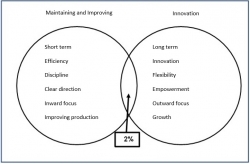This article references the books Winning, by Jack Welch, and The Definitive Drucker, by Elizabeth Haas Edersheim.
If you have a convenience store at a gas station, you need to stock a number of essential items customers might suddenly need, or buy impulsively when they stop to fill up. Nobody does their weekly grocery shop at a gas station.
As an owner of a convenience store you wouldn't have much competition, and you wouldn't concern yourself with drawing customers - they'll come to you.
It's enough for the store to be clean, organized, and reasonably lit. Stock can be limited. Usually you wouldn't have different brands of the same product, and prices can be relatively high.
On the other hand, if you have a local grocery store, your customer base is nearby shoppers who'd rather not travel to the big supermarket at the shopping center. You would need to draw customers in. So you'll offer more variety, and your prices have to be low enough so that people don't prefer to travel to the big supermarket.
Those big supermarkets at shopping centers face other challenges. Often competition is steep, and more considerations come into play - easy parking, varied stock and sizes, pricing, ease of shopping, number of tills, cleanliness, etc.
When Meshek Fine opened a large produce store at a large shopping centre, they realized their challenge is to tempt customers to travel over half an hour to buy fruits and vegetables, rather than buy at local stores.
Their sales strategy is to guarantee higher quality and lower prices than urban customers might find close to them.
They know that if they're not number one for their customers - those customers won't come. People won't travel the distance if they don't feel they're getting a good deal that they can't find elsewhere.
Be Number One or Number Two, Fix or Close
Jack Welch was chairman and CEO of GE for over 20 years. In his book, Winning, he writes how from 1981 to 1995 GE aimed to be number one or two in every market - and fixed, sold or closed every business failing to achieve this goal. Nestle used to follow the same strategy (be number one or two, fix or close), and since I know Welch used to consult with Peter Drucker, I thought the idea originated with Drucker.
But in Elizabeth Haas Edersheim's book The Definitive Drucker, she identifies it as coming from Welch.
I consider this strategy a brave one, because any decision to close a business as part of a development process requires bravery and determination.
How Big Do You Need to Be in Order to Be Number One Globally?
I’ve shown how Meshek Fine implemented the number one strategy on a regional scale, in order to draw customers from a distance. But that’s still not a global scale.
Can only large companies like GE or Nestle be number one or two globally?
Absolutely not. Let’s look for example at a small Israeli startup called Spetz.io, founded by three partners and bought by Prodex in 2021.
I had the chance to get to know Yam Dvir, Spetz’s CEO, last year. He was always looking beyond the local market, seeking to innovate on a global scale.
I could cite Teva or Elbit, but I chose Spetz because it was founded in 2017 and only had 750 thousand dollars in funding. A small company working in the dull field of employee recruitment, but thinking on a global scale from the start, looking to be number one.
There is of course also the example of Shamir Optical Industries, which I refer to often (for example see my article on the Blue Ocean strategy) because, having been its CEO, I know it well.
I started working at Shamir Optical when the company was at its lowest point, and the owners were planning to close it. Along with my management team we created a strategy which innovated on a global scale. We didn’t call our strategy “be number one or two”, but that’s what it was in practice. We had the knowledge necessary to plan and manufacture multifocal lenses, which at the time only a few large companies could do. We offered those much bigger companies to plan multifocal lenses for them to manufacture. At the time this was a brave and innovative approach. It put us under the spotlight in the relatively small global market of Ophthalmology and enabled us to grow rapidly within a few short years.
These three examples (Meshek Fine, Spetz, and Shamir Optical Industries), as well as others you might be familiar with, show us how anyone can. Every company can aim to be number one in its field, locally or globally.
What Are You Aiming For?
If you’re only focused on delivering your next order, and are willing to sell at a ridiculously low price to achieve that - you have a problem.
The problem isn’t your capabilities, but how you look at your business environment.
Some companies have bad cash flow, and can barely pay wages. Then, the CEO can hardly look up and think of changes. Certainly not plan to become number one.
On the other end of the success spectrum, are companies doing well, where the CEO thinks, if all’s well why initiate change.
Between these two ends is a vast spectrum, and most CEOs there will reach one of two decisions: they’ll either think they can’t initiate change because the company isn’t doing well, or that there’s no need for change because the company’s doing well.
But change is necessary for two main reasons:
- The business environment is an ever changing one, and if you stick to what’s familiar, what was suitable in the past, you might find yourself unprepared for the coming changes, and get left behind. You could become obsolete.
- Your competitors are moving forward, developing cheaper, or better quality products - or both.
How to Become Number One in Your Market
If I was in your shoes, the first thing I’d do is analyze the profitability of all products or fields of operation.
Those showing a loss or decline in profits - I’d close.
Those showing profit or growth - I’d developed.
Development plans should aim to create a number one product, at least locally if not globally.
This process must include more people in your company, in order to brainstorm which products (existing or new) could become number one, and how.
It’s not easy. We’re all set in our familiar ways, comfortable in what’s known. So the decision to eliminate some products and develop others, can be a hard one.
A new CEO can be free of emotional weights and preconceptions, and could find the process easier. Jack Welch first presented this strategy when he was a new CEO of GE. But this isn’t a reason to change CEOs. This is only to say that CEOs need to acknowledge these obstacles in their thinking. The best way to do this is to think, what would a new CEO do now? Here, too, working with a team can be very beneficial, and lead to more creativity.
Summary and Recommendations
When Jack Welch became General Electrics' CEO, he set a policy that for every field the company operates in, they must be number one or two globally. Otherwise, that aspect of the company will be fixed, or closed.
Nestle follows a similar strategy, and so might other global companies.
But you don’t have to be a global giant in order to follow this strategy. A small nine-employee startup called Spetz did just that.
In fact, any company can adopt this strategy, and I suggest you do so yourself.












 My First Book: Manage! Best Value Practices for Effective Management
My First Book: Manage! Best Value Practices for Effective Management